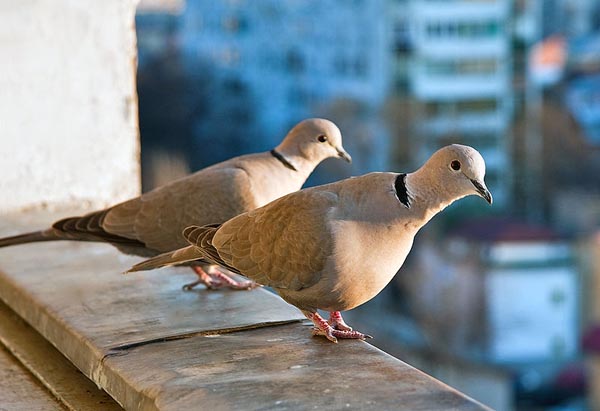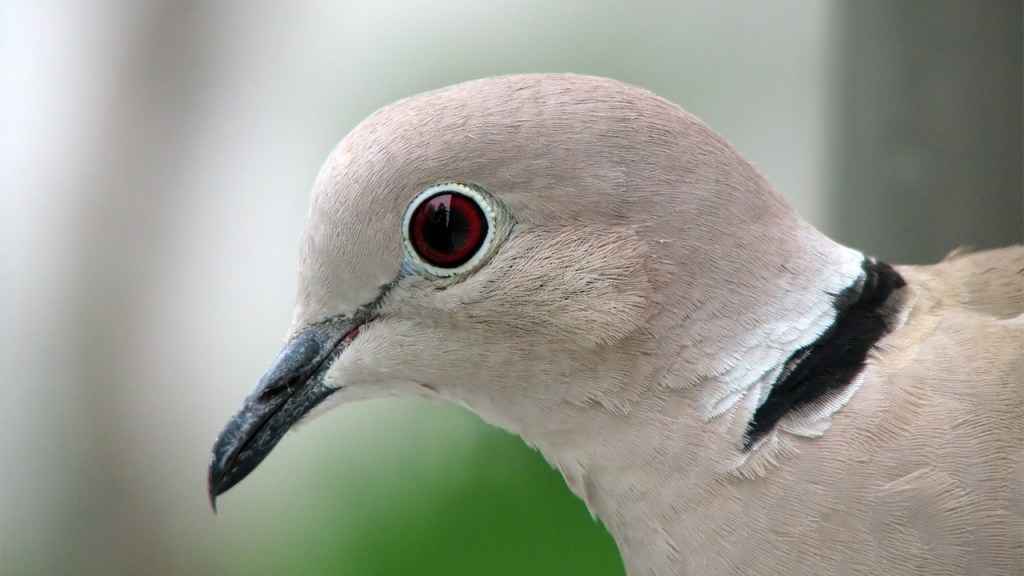The Great Backyard Bird Count (GBBC) — one of the largest citizen science initiatives in the world – annually documents a wide variety of bird population trends.
To my mind, one of the most interesting has been the dramatic spread of the non-native Eurasian collared dove across North America.
The GBBC asks citizen birders to watch an area for at least twenty minutes sometime during a four-day period in mid-February (this year’s count concluded yesterday), and record the birds they see.
Just ten years ago, seeing a Eurasian collared dove would have been a novelty. No more: the doves are now commonly reported by birders in most of the United States.
GBBC data tell the story of this rapid spread.
In the 1970s, the Eurasian collared dove was introduced to the Bahamas. By the early 1980s, the non-native birds made their way to South Florida, where they established populations. Then they began spreading north and west.
Their range appears to have expanded slowly at first. A look at GBBC reports from 1998 show a lot of sightings in Florida, with some birds reported in Texas, Alabama and Arkansas.
By 2001, the doves reached California.
Last year’s bird count results showed the Eurasian collared dove had colonized much of the country. It has not (yet) been reported in New England, but it has reached as far north as Alaska.
The GBBC’s video map dramatically illustrates this expansion.
In my state of Idaho, the doves were first recorded in 2005 by two backyard birders. In subsequent years, the bird was commonly reported in Idaho’s eastern corners. Last year, 132 GBBC participants reported 719 doves throughout the state.
I saw my first Eurasian collared dove in our backyard in 2008 – a banded bird that may have been an escaped pet. Last year, I began seeing the doves hanging around our neighborhood. This year was the first that I noted the species during my own participation in the Great Backyard Bird Count.
What’s going on here? Should conservationists be concerned about this spread?
Unlike some dove species, Eurasian collared doves aren’t migratory. However, they do readily expand into new suitable habitat. In fact, in their native Asia, Eurasian collared doves have been rapidly expanding their range as well – colonizing new countries every year.
The dove is one of those species that adapts well to humanity. The trees, power lines and bird feeders of suburbia provide perfect habitat. The Eurasian collared dove is almost always seen near homes and farms, not unbroken forest or prairie.
Research indicates it is not adversely affecting native mourning doves or other birds. It may simply be filling a new habitat niche created by suburban habitat. But it is still early in the spread.
Could Eurasian collared doves become an invasive threat? That remains to be seen.
Citizen science projects like the GBBC and another citizen initiative, Project FeederWatch, will help scientists continue to track the spread and impacts of the species. It will be interesting to learn what this year’s count found about Eurasian collared doves. If past years are any indication, their populations will likely have grown and spread into new areas of the country.
Have you seen Eurasian collared doves in your area? Have you noted other trends during your backyard bird counts? Let us know what you’re seeing!





THEY FIGHT ALL THE TIME
I have seen an occasional lone bird here in Troutdale & Gresham, Oregon area – East of Portland. Have not seen a pair yet.
Living in southern Arizona for the past 20 years, I’ve watched bird populations change. Especially the transition from white-winged doves to Eurasian collared doves just in the past 3 years. Now, I only see the Eurasian collared doves and not a white-winged dove in the batch here in Rio Rico, AZ. Where did they go or are white-winged doves domed to inter-breeding?
We live in a high rise and we have one that visits us everyday. Sometimes it flies into our glass doors multiple times seeming to want to come in. A few times he came with a friend.
On a recent trip to Hat Rock State Park (NE Oregon on the Columbia River) I distinctly heard a Mourning Dove pair calling from one side of the park as well as a Collared Dove pair calling from the other side of the park. Not two species talking to teach other, but two species in the same area talking to a like bird. I used to hear Mourning Doves only. Now I usually hear Collared Doves only. I don’t know if the CDoves are aggressive, or if they eat all the food, or if they lay eggs in MDoves’ nests, or if MDoves just don’t like to be around CDoves; but there USED TO BE MDoves, now there are mostly CDoves in Portland, Hermiston and Hat Rock State Park, Oregon.
Yes, a pair hanging out here in Valley Center, CA, 92082. They like the big live oak and the bluebird feeder. At certain times of year there are more, but this one pair seems to call it home.
Thanks Matthew,
I was researching doves as it would seem, a lone dove that looks very close to this one (a bit lighter in color) has taken residence in my tree. It’s been there now few weeks. Has my dog fascinated and me very curious. I have a feeder in my yard that attracts a few species…(especially that furry black one….I believe it’s called a squirrel) This one just keeps coming back…actually it’s there most of the day. I worry that it’s by itself but seems content enough to just hang out, feed off the ground and even drinks out of the bowl or water I have supplied. I live just outside of Ottawa, Canada in a small town called Kemptville. There was no mention of these doves in Canada, just thought I’d pass this along.
We’ve been feeding birds in a rural farmland area in NW Montana for 15 years. Started seeing the Eurasian Doves in early spring, 2019. First a pair and then dozens of pairs; apparently we have the perfect environment for them. Problem is the overall non-dove populations are way down: pine siskins tolerated them for awhile but now they’re mostly gone. No more goldfinches, nuthatches, grosbeaks, house finches or chickadees… most all of our normal birds do not visit anymore. I have noted when the ED’s fly in like a squadron of Harriers the few birds around scatter. I have read quite few blogs about the ED’s and only a few people have also noted a decline in their regular feeder birds. Just adding my two cents. The ED’s are lovely but I miss the rest of the crew.
Yes and twice a few of Doves, and also on top of it A white band piegion hang around with them a few of them for the last roughly 5 years.
We have something similar in our backyard. They are much larger and lighter colored than the mourning doves. Their coo is different and they come in the afternoons instead of mornings. Their flight is silence, rather than the whistling sound morning doves make. The main difference is the black strip on their necks is very slim and does not have white around it, as in these pictures.
I saw an extremely large bird with a wee bit of white on it’s face. It almost landed on my shoulders. I’d like to know what kind of bird it is! I’m in Vernon BC
these guys have become relatively common here in Humboldt county California. I first saw them in the seacoast village of Trinidad as well as the nearby townof mckinleyvill this (guessing) around 20 years ago.
I’ve got one right here. Found it in our front yard garden. Im wondering if it’s someone’s pet because it didn’t fly away when I approached it and it let me pick it up. The fact that it let me pick it up also tells me that it may not be able to fly. I decided I better bring it in since we have cats all over our place, including the one I just let out and started sneaking up on the dove the second he spotted it. I have it in the bedroom with me in an open cat carrier. I know nothing at all about the care of doves or any other bird for that matter so now I’m sitting here trying to figure out what to do. I pulled some weeds that have gone to seed along with some blooms from my strawberry kiwi fruit tree and put them in the cat carrier with the dove. Also put some rosemary, thyme and sesame seeds from my kitchen in with the weeds but doubt that they’re fresh enough or if the dove or that it will even be interested in them. Gave it a small heavy shallow bowl of water that’s too heavy to knock over. I have two cats in the house that are not allowed outside and are of course anxious to get in my room since they’re the ones that alerted me to the little thing in my front garden and they watched me thru the front window as I went out, picked up and brought it into my room. I’ll be damnedest if I’m going to let them get anywhere near the dove. Does anyone have any idea if there is someone in my area I can call for help for this poor little critter. I’m in Los Angeles County and I don’t have transportation to take it to a rescue place, thou I doubt that one exist in my area.
We spotted this Dove in our back yard about a week ago (Mid May 2019) and thought it might be a homing pigeon or a released dove at first because it was so much whiter and a very pretty bird. Found a description of a Barbary dove which matches exactly. It has been hanging around and getting along pretty well so it does know how to forage and fed for itself. We are in the Enoch/Cedar City, Utah area.
I was so sad after having a mating pair of these doves in my yard and going out one day to find long and copious amounts of feathers on the ground. I assume a hawk got one. I looked for an injured bird and never found one so I assume the hawk ate it. But, yes, they are beautiful and they are seen here in Riverside CA.